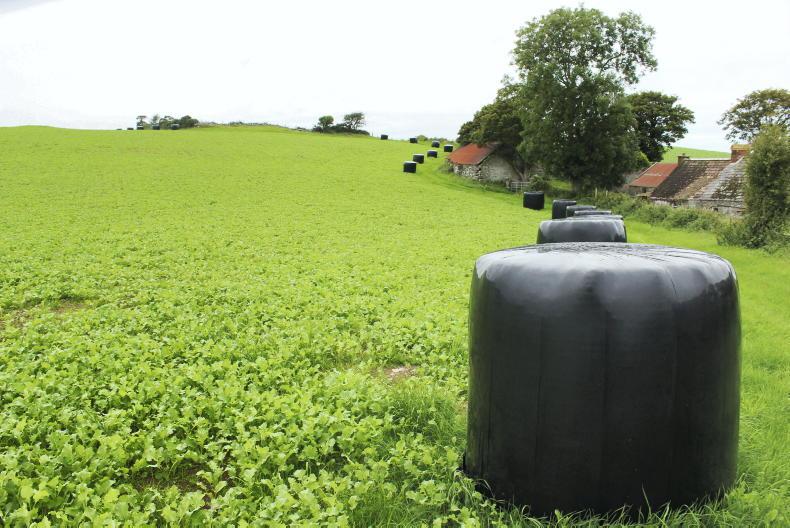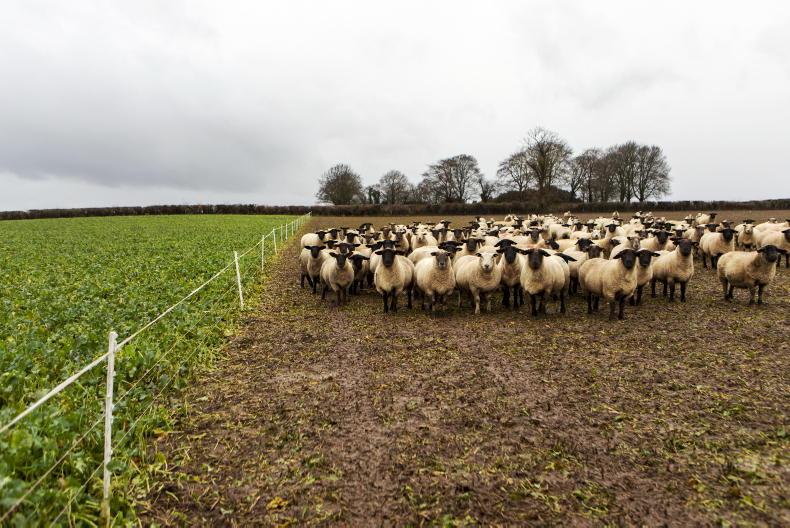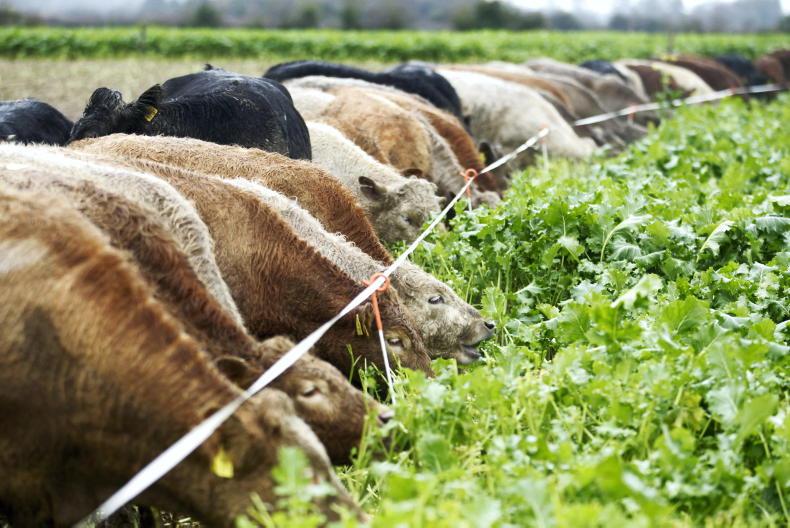Keeping cows indoors with bedding and feed can cost a Scottish farmer around £1.60 to £1.95 /day, whereas grazing hybrid brassicas can cost as little as £1/day on a per head basis.
So, keeping 40 spring-calving cows outside from November until the end of January can save £2,160 in direct feed and bedding costs. It also frees up shed space before calving, which can be utilised by weanlings before the early spring sales of store cattle.
Alternatively, finishing lambs on forage crops can help take advantage of higher prices around Christmas and into the New Year.
Last year, lambs sold as stores in early autumn were half the value of finished lambs in February.
In the coming weeks, winter barley will be harvested across Scotland, giving many farmers the opportunity to sow a winter fodder crop directly into stubbles in August. Forage rape, or a kale/rape hybrid, is also a good option to follow a late summer silage harvest as well.
Fast growing crops
These fast growing crops can grow on poorer soils or exposed sites, and are ideal for fattening lambs, flushing ewes before the tup or outwintering cattle.
Farmers can sow the forage rape and hybrids from May until August, with different varieties suited to different sowing dates.

Strategically placing wrapped silage bales for winter consumption can reduce the need to bring tractors into the field in the wet.
Later-sown varieties tend to be forage rape or hybrid that can establish enough ground cover before winter and be ready to graze from October through to February.
Such crops can provide a dry matter yield of between 3.5t to 4t per hectare, or a fresh weight yield of 25 to 35t/ha. The crude protein the plant is 19-20% with 10 to 11ME/kg DM and a digestible value of 65%.
Direct drilling or ploughing can both be used to establish the crop. Min-till options have the advantage of being cheaper and quicker to establish the crop in stubble ground. However, from experience, ploughing will help reduce competition from other plants by providing a more stale seedbed. Direct drilling requires 2kg to 3kg of seed per acre, while broadcasting requires 3kg to 4kg per acre.
Seedbed preparation
The seedbed should be fine and firm for establishing plants.
Soil moisture is also critical to kick off plant growth. After winter barley, farmers can either plough, disc or cultivate the ground, depending on soil conditions. Following a grass lay with a forage crop, many farmers choose to spray off the grass and take a min-till approach.
Direct drilling is a particularly attractive option when cattle graze the crop, as it offers firmer ground to stand on and reduces poaching in wet conditions. The seeds should be planted at a depth of 1cm. After sowing, it is recommended that the crop is rolled to consolidate the seedbed and help reduce moisture loss.
Farmers often apply a top dressing of nitrogen once the plants emerge, with around 75kg/ha to maximise growth rates
Applying a NPK compound fertiliser such as 60-90kg/ha of nitrogen and 25kg/ha of P and 25kg/ha of K into the seedbed is recommended. But check the previous crops in the field and adjust the fertiliser needs accordingly. Farmers often apply a top dressing of nitrogen once the plants emerge, with around 75kg/ha to maximise growth rates.
Brassicas like a high pH in the soil, so lime could also be required to reach yield potential. The growing costs have been calculated by the Farm Advisory Service (FAS) in Scotland at around £270/ha (£109/ac), which is based on ploughing the field as opposed to direct drilling. This works out at £77/t of DM.
Grazing
Fodder crops are low in fibre, so they need to be supplemented with either straw or silage at around 25% of daily dry matter intake. Farmers looking to plan ahead can leave wrapped bales in the field after the crop is sown out. Bales can then be opened in winter with a ring feeder placed over them. This avoids tractors entering the field when ground conditions are poor.
There is also the need to ensure mineral supplementation is available, as fodder crops can be low in magnesium, copper and iodine. To avoid digestive upsets in livestock, it is best to phase the animals onto the fodder crop over two weeks.
If outwintering cattle on the fodder crop, then access to a grass or stubble field is recommended as a lie back area during wet conditions
Strip grazing by moving the electric fence every day is the ideal technique to best utilise the crop. The longer and narrower the strip, the better, as it reduces the amount to trampling on the crop, while maximising the amount of fodder available per animal.
If outwintering cattle on the fodder crop, then access to a grass or stubble field is recommended as a lie back area during wet conditions.
One downside to fodder crops is they can potentially be toxic during heavy frosts. During frosty weather, do not move the fence until crops have thawed out.
£1.11/day/cow
During the Farm Profit programme, Arthur Duguid outwintered cows on Swift, a forage rape/kale hybrid. Daily feed costs calculated out at £1.11/day/cow.
This was calculated with two-thirds of the cows’ diet consisting of Swift at £56/t of dry matter and one-third of the diet from straw priced at £120/t.
The lower cost of the crop compared to the FAS figures can be partly put down to direct drilling being significantly cheaper than conventional ploughing and sowing. Plus, the rolling and fertilising of the crop was done by Arthur, as opposed to a contractor, which the FAS costs were based on.
How many animals
For 100 days of grazing with a typical yield of 3.5DMt/ha, one hectare of a forage crop can keep 29 ewes, 23 lambs, three cows or five store cattle, according to studies by the Agriculture and Horticulture Development Board (AHDB). This is based on a pregnant ewe eating 1.6% of her liveweight per day, lambs eating 3% and cattle eating 2.2%.

Flushing ewes or finishing lambs is a good use for forage rape.
But it is recommended that you measure the yield of the field before putting in the livestock, as different growing conditions and land type can result in varying yields.
Cows on a rape/kale hybrid diet with straw or silage should be able to maintain condition through winter before calving in spring. Studies by AHDB in England have shown lambs with a daily Liveweight Gain of 273g. It was calculated to cost 20p/day compared to 39p/day on a diet of concentrates.
It is recommended that once lambs go onto the fodder diet, they remain on it until they reach slaughter weight, as changing diets too often can reduce feed efficiency, due to the time it takes for the animals to transition between diets.
Keeping cows indoors with bedding and feed can cost a Scottish farmer around £1.60 to £1.95 /day, whereas grazing hybrid brassicas can cost as little as £1/day on a per head basis.
So, keeping 40 spring-calving cows outside from November until the end of January can save £2,160 in direct feed and bedding costs. It also frees up shed space before calving, which can be utilised by weanlings before the early spring sales of store cattle.
Alternatively, finishing lambs on forage crops can help take advantage of higher prices around Christmas and into the New Year.
Last year, lambs sold as stores in early autumn were half the value of finished lambs in February.
In the coming weeks, winter barley will be harvested across Scotland, giving many farmers the opportunity to sow a winter fodder crop directly into stubbles in August. Forage rape, or a kale/rape hybrid, is also a good option to follow a late summer silage harvest as well.
Fast growing crops
These fast growing crops can grow on poorer soils or exposed sites, and are ideal for fattening lambs, flushing ewes before the tup or outwintering cattle.
Farmers can sow the forage rape and hybrids from May until August, with different varieties suited to different sowing dates.

Strategically placing wrapped silage bales for winter consumption can reduce the need to bring tractors into the field in the wet.
Later-sown varieties tend to be forage rape or hybrid that can establish enough ground cover before winter and be ready to graze from October through to February.
Such crops can provide a dry matter yield of between 3.5t to 4t per hectare, or a fresh weight yield of 25 to 35t/ha. The crude protein the plant is 19-20% with 10 to 11ME/kg DM and a digestible value of 65%.
Direct drilling or ploughing can both be used to establish the crop. Min-till options have the advantage of being cheaper and quicker to establish the crop in stubble ground. However, from experience, ploughing will help reduce competition from other plants by providing a more stale seedbed. Direct drilling requires 2kg to 3kg of seed per acre, while broadcasting requires 3kg to 4kg per acre.
Seedbed preparation
The seedbed should be fine and firm for establishing plants.
Soil moisture is also critical to kick off plant growth. After winter barley, farmers can either plough, disc or cultivate the ground, depending on soil conditions. Following a grass lay with a forage crop, many farmers choose to spray off the grass and take a min-till approach.
Direct drilling is a particularly attractive option when cattle graze the crop, as it offers firmer ground to stand on and reduces poaching in wet conditions. The seeds should be planted at a depth of 1cm. After sowing, it is recommended that the crop is rolled to consolidate the seedbed and help reduce moisture loss.
Farmers often apply a top dressing of nitrogen once the plants emerge, with around 75kg/ha to maximise growth rates
Applying a NPK compound fertiliser such as 60-90kg/ha of nitrogen and 25kg/ha of P and 25kg/ha of K into the seedbed is recommended. But check the previous crops in the field and adjust the fertiliser needs accordingly. Farmers often apply a top dressing of nitrogen once the plants emerge, with around 75kg/ha to maximise growth rates.
Brassicas like a high pH in the soil, so lime could also be required to reach yield potential. The growing costs have been calculated by the Farm Advisory Service (FAS) in Scotland at around £270/ha (£109/ac), which is based on ploughing the field as opposed to direct drilling. This works out at £77/t of DM.
Grazing
Fodder crops are low in fibre, so they need to be supplemented with either straw or silage at around 25% of daily dry matter intake. Farmers looking to plan ahead can leave wrapped bales in the field after the crop is sown out. Bales can then be opened in winter with a ring feeder placed over them. This avoids tractors entering the field when ground conditions are poor.
There is also the need to ensure mineral supplementation is available, as fodder crops can be low in magnesium, copper and iodine. To avoid digestive upsets in livestock, it is best to phase the animals onto the fodder crop over two weeks.
If outwintering cattle on the fodder crop, then access to a grass or stubble field is recommended as a lie back area during wet conditions
Strip grazing by moving the electric fence every day is the ideal technique to best utilise the crop. The longer and narrower the strip, the better, as it reduces the amount to trampling on the crop, while maximising the amount of fodder available per animal.
If outwintering cattle on the fodder crop, then access to a grass or stubble field is recommended as a lie back area during wet conditions.
One downside to fodder crops is they can potentially be toxic during heavy frosts. During frosty weather, do not move the fence until crops have thawed out.
£1.11/day/cow
During the Farm Profit programme, Arthur Duguid outwintered cows on Swift, a forage rape/kale hybrid. Daily feed costs calculated out at £1.11/day/cow.
This was calculated with two-thirds of the cows’ diet consisting of Swift at £56/t of dry matter and one-third of the diet from straw priced at £120/t.
The lower cost of the crop compared to the FAS figures can be partly put down to direct drilling being significantly cheaper than conventional ploughing and sowing. Plus, the rolling and fertilising of the crop was done by Arthur, as opposed to a contractor, which the FAS costs were based on.
How many animals
For 100 days of grazing with a typical yield of 3.5DMt/ha, one hectare of a forage crop can keep 29 ewes, 23 lambs, three cows or five store cattle, according to studies by the Agriculture and Horticulture Development Board (AHDB). This is based on a pregnant ewe eating 1.6% of her liveweight per day, lambs eating 3% and cattle eating 2.2%.

Flushing ewes or finishing lambs is a good use for forage rape.
But it is recommended that you measure the yield of the field before putting in the livestock, as different growing conditions and land type can result in varying yields.
Cows on a rape/kale hybrid diet with straw or silage should be able to maintain condition through winter before calving in spring. Studies by AHDB in England have shown lambs with a daily Liveweight Gain of 273g. It was calculated to cost 20p/day compared to 39p/day on a diet of concentrates.
It is recommended that once lambs go onto the fodder diet, they remain on it until they reach slaughter weight, as changing diets too often can reduce feed efficiency, due to the time it takes for the animals to transition between diets.









 This is a subscriber-only article
This is a subscriber-only article










SHARING OPTIONS: